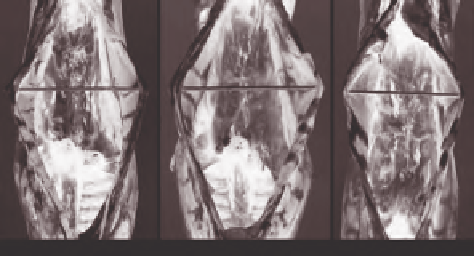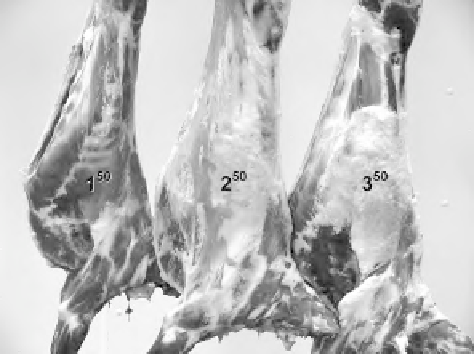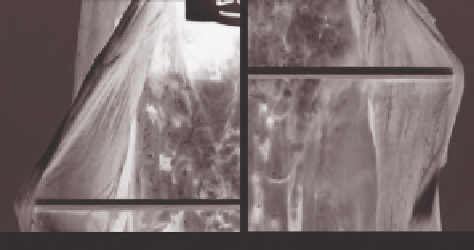Agriculture Reference
In-Depth Information
B
30
Figure 13.4
Flank lean color indicates relative
maturity of carcasses, with darker color
indicating more advanced physiological
maturity. Shown are scores of A
30
and B
30
, with
each color group ranging from 0 to 100. Color
groups C, D, and E are associated with goats
older than yearlings and are not shown. For
color detail, see Appendix A.
A
30
1%
2%
3.5%
Figure 13.2
Kidney and pelvic fat of 1%, 2%, and
3.5% in meat goat carcasses. For color detail,
see Appendix A.
F
ACTORS
A
FFECTING
M
EAT
Q
UALITY
Quality parameters are estimated to group carcasses by
anticipated palatability. The youthfulness of beef and lamb
carcasses is determined by bone structure and muscle
color. Pork carcasses are evaluated for acceptable color,
fi rmness, and texture. The relative physiological age of
goats can be determined by the relative degree of ossifi ca-
tion of the leg bones and the color of the fl ank muscles in
goat carcasses similar to the determination of physiologi-
cal maturity in lamb carcasses. The amount of intramus-
cular fat (marbling) is also subjectively scored in beef
carcass
Longissimus dorsi
muscles to provide an indication
of juiciness and fl avor. Goat meat customers do not want
to purchase goat carcasses with fat.
Muscles with higher amounts of pigment and darker
color are associated with increased animal age. Flank
lean color gives a relative indication of the physiological
age of the animal. The fl ank muscle is one of the few
muscles that can be easily observed on a goat carcass.
Examples of the two lightest color scores are shown in
Figure 13.4 .
Figure 13.3
Subcutaneous fat cover scores to
estimate the external fat deposition on meat
goat carcasses with carcasses showing the
midpoint for each fat score (1
50
, 2
50
, and 3
50
),
with 1 = minimal or none, 2 = fat over rib and
shoulder, and 3 = excessive fat cover. For color
detail, see Appendix A.
A subjective estimation of the subcutaneous fat covering
is made for goat carcasses rather than an objective linear
measurement because there is little or no fat deposition
over the
Longissimus dorsi
muscle on the back except
when goats are undesirably over fat, the fat deposition
pattern is not uniform over the body, and it is diffi cult to
accurately measure the thickness of the fat covering. The
three degrees of fat cover scores are in Figure 13.3.
Carcass Fabrication and Cuts
Primal cut proportions of carcasses are more infl uenced by
fabrication method than by other factors (McMillin et al.,
1998). Buck kid goats had higher shoulder and lower leg
and loin percentages compared with doe and wether kid
goats (Wildeus et al., 2007), which is representative of the











